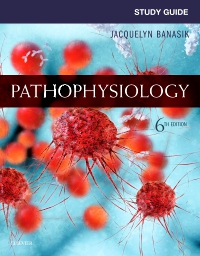
Study Guide for Pathophysiology - Elsevier eBook on VitalSource, 6th Edition
Elsevier eBook on VitalSource

The ultimate study tool to help your students master pathophysiology! Corresponding to the chapters in the Pathophysiology, 6th Edition textbook, this study guide helps students review and practice the material with a variety of exercises and question types, including multiple choice, true/false, matching, fill in the blank, compare/contrast, and labeling. Thorough updates include nearly 50 case studies that provide real-life examples of how students will use pathophysiology in their careers.
Newer Edition Available
Study Guide for Pathophysiology - Elsevier eBook on VitalSource
-
- More than 1,500 questions in a variety of question types reinforce student understanding with multiple choice, true/false, fill in the blank, and matching questions, plus labeling exercises and compare/contrast tables.
- Approximately 250 case study questions are included at the end of each unit, and rationales to the answers are provided in the answer key.
- NEW! Thoroughly updated content matches the 6th edition of textbook.
- Answer key is conveniently located in the back of the study guide.
-
- NEW! Thoroughly updated content matches the 6th edition of textbook.
-
Unit I: Pathophysiologic Processes
1. Introduction to Pathophysiology
2. Homeostasis and Adaptive Responses to StressorsUnit II: Cellular Function
3. Cell Structure and Function
4. Cell Injury, Aging, and Death
5. Genome Structure, Regulation, and Tissue Differentiation
6. Genetic and Developmental Disorders
7. NeoplasiaUnit III: Defense
8. Infectious Processes
9. Inflammation and Immunity
10. Alterations in Immune Function
11. Malignant Disorders of White Blood Cells
12. HIV Disease and AIDSUnit IV: Oxygen Transport, Blood Coagulation, Blood Flow, and Blood Pressure
13. Alterations in Oxygen Transport
14. Alterations in Homeostasis and Blood Coagulation
15. Alterations in Blood Flow
16. Alterations in Blood PressureUnit V: Cardiac Function
17. Cardiac Function
18. Alterations in Cardiac Function
19. Heart Failure and Dysrhythmias: Common Sequelae of Cardiac Diseases
20. ShockUnit VI: Respiratory Function
21. Respiratory Function and Alterations in Gas Exchange
22. Obstructive Pulmonary Disorders
23. Restrictive Pulmonary DisordersUnit VII: Fluid, Electrolyte, and Acid-Base Homeostasis
24. Fluid and Electrolyte Homeostasis and Imbalances
25. Acid-Base Homeostasis and ImbalancesUnit VIII: Renal and Bladder Function
26. Renal Function
27. Intrarenal Disorders
28. Acute Kidney Injury and Chronic Kidney Disease
29. Disorders of the Lower Urinary TractUnit IX: Genital and Reproductive Function
30. Male Genital and Reproductive Function
31. Alterations in Male Genital and Reproductive Function
32. Female Genital and Reproductive Function
33. Alterations in Female Genital and Reproductive Function
34. Sexually Transmitted InfectionsUnit X: Gastrointestinal Function
35. Gastrointestinal Function
36. Gastrointestinal Disorders
37. Alterations in Function of the Gallbladder and Exocrine Pancreas
38. Liver DiseasesUnit XI: Endocrine Function, Metabolism, and Nutrition
39. Endocrine Physiology and Mechanisms of Hypothalamic-Pituitary Regulation
40. Disorders of Endocrine Function
41. Diabetes Mellitus
42. Alterations in Metabolism and NutritionUnit XII: Neural Function
43. Structure and Function of the Nervous System
44. Acute Disorders of Brain Function
45. Chronic Disorders of Neurologic Function
46. Alterations in Special Sensory Function
47. PainUnit XIII: Neuropsychological Function
48. Neurobiology of Psychotic Illnesses
49. Neurobiology of Nonpsychotic IllnessesUnit XIV: Musculoskeletal Support and Movement
50. Structure and Function of the Musculoskeletal System
51. Alterations in Musculoskeletal Function: Trauma, Infection, and Disease
52. Alterations in Musculoskeletal Function: Rheumatic DisordersUnit XV: Integumentary System
53. Alterations in the Integumentary System
54. Burn Injuries



 as described in our
as described in our 